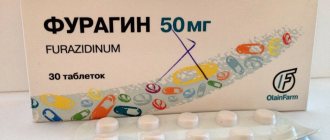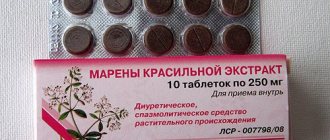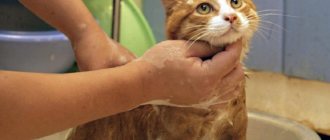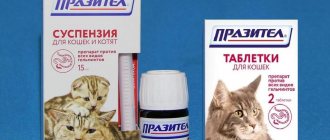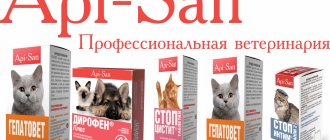6923Pavel
Many breeders are in no hurry to contact qualified veterinary clinic specialists at the first signs of diarrhea in their pet, preferring to self-medicate. After all, the famous Furazolidone for cats often becomes a real salvation in such a situation. However, diarrhea in your beloved pet clearly indicates a disruption in the digestive tract. It is a mistake to assume that with such an illness the cat is completely safe and its condition is not critical.
Chemical composition
The composition of the drug "Furazolidone" includes the active substance of the same name in an amount of 50 mg. The following additional elements are also added to the tablets: potato starch, lactose monohydrate, colloidal anhydrous silicon dioxide, potassium stearate.
The product is produced in Russia, Belarus, and Ukraine. Since it is used both in medicine and veterinary medicine, you can buy it in a regular pharmacy chain.
Did you know? The oldest remains of a domestic cat to date have been found in Cyprus. Archaeologists date them back to 7500 BC. e. The animal was buried along with the person.
Storage conditions
As the manufacturer indicates, the drug can be used within 3 years after its release.
The drug should be stored indoors, in a temperature range of 0. +25°, in the absence of humidity and exposure to sunlight. It should be kept out of the reach of children and pets, away from food and drinks.
Qualified veterinary clinic specialists prescribe Furazolidone for cats if necessary to eliminate various types of bacteria and microbes. International nonproprietary name of the drug Furazolidone. It is produced in the form of tablets for oral administration, which have a pronounced antiseptic and antimicrobial effect. Before giving Furazolidone to your pet, you must consult a veterinarian and carefully study the instructions included with the tablets.
Is it possible to give a kitten "Furazolidone"
Since small kittens have a fragile immune system, infectious processes develop at lightning speed, and diarrhea can lead to dehydration in the shortest possible time, they cannot be treated independently.
“Furazolidone” is not used in veterinary practice for kittens, since it is difficult to divide the tablet according to small weight and there is a high risk of overdose. If you feel unwell, you should immediately seek veterinary help to avoid serious consequences for the baby’s health. Based on examination, symptoms and tests, the veterinarian will determine the cause of the kitten’s illness and prescribe effective treatment.
Causes of diarrhea in a kitten
A kitten that has recently arrived at home may develop diarrhea due to:
- A sudden change in nutrition - if you buy a kitten during the adaptation period, you need to feed it with its usual food and according to an established schedule. If you pick up a baby on the street, a slight digestive upset cannot be avoided. If you don’t know what your pet ate during the first days, try to feed it neutrally.
- Worm infestation is an especially common case if the baby was taken from the street.
- Viral, infectious, bacterial disease - small kittens are vulnerable to most infections. If the baby is cold, has not slept for a long time, or has not eaten well, his immunity will weaken.
- Eating spoiled food and bones – applies to kittens picked up from the street or having free access to a walk.
- Stress can most likely cause diarrhea if you recently got a kitten. The cause of stress can be another pet, punishment, the arrival of guests, moving, excessively active games, lack of sleep, regular overeating, blood-sucking parasites, bathing and much more.
Treatment methods differ depending on the type of diarrhea, its duration and the condition of the pet:
- In case of acute diarrhea, treatment is carried out with shock, but not long-term.
- The chronic form depletes the body, so gentle and supportive therapy is used.
- Diarrhea that goes away and disappears on its own indicates a systemic disorder, but the cause may be related not only to health, but also to care.
Before treating a kitten, especially without a doctor’s prescription, be sure to analyze the situation. Measure the temperature; if it is elevated, it is not diarrhea that needs to be treated, but most likely a virus or infection. Take an anamnesis and inspect the home; perhaps the kitten swallowed a thread, a piece of oilcloth, or stole something from the trash can. Again, in this case, treatment of diarrhea is disastrous; it will lead to the loss of invaluable time and blurring of the clinical picture.
The danger of self-medication is that diarrhea may be the first symptom of a serious illness.
Usually, if we are talking about a virus, infection or pathology, in addition to diarrhea, the kitten experiences vomiting, changes in body temperature, refusal to eat and apathy.
The principle of action of the drug
The active substance of the drug destroys harmful bacteria and microbes that lead to disruption of the animal’s digestive tract.
It has a detrimental effect on salmonella, streptococci, protea, fungi of the genus Candida, lamblia, trichomonas, coccidia, and colibacteria. The effect of the drug on Pseudomonas aeruginosa and anaerobic bacteria does not apply.
Absorption of the drug into the stomach and intestines occurs slowly. It is excreted in urine and feces within 1–2 days. One of the advantages of the drug is that the resistance of pathogenic microorganisms to the active substance develops slowly.
Did you know? According to the Guinness Book of Records, the tallest cat in the world is a Savannah cat named Trouble.
His height was 48 cm.
What you need to know about the drug
Furazolidone was often used in veterinary practice in the last century. Today the drug has somewhat lost its relevance. The reason is the emergence of a large number of highly active bactericidal agents that belong to a new generation. However, with diarrhea, many owners continue to give Furazolidone to their cat. The product belongs to nitrofurans. Their bactericidal effect on microbes was discovered about a century ago. The cost of Furazolidone is very modest. But this does not prevent it from demonstrating more powerful results when used than competing products.
The drug promotes the active destruction of various types of bacteria and microbes. At the same time, at the correct dosage, the product does not have a toxic effect on the cat’s body. The drug is absorbed very slowly in the intestines and stomach. It is excreted by the kidneys within 1-2 days . But throughout the entire period of time it continues to perform its function, helping to destroy microbial cells, quickly alleviating the cat’s condition. In comparison with similar agents, a huge advantage of Furazolidone is that resistance of microorganisms to it develops extremely slowly.
Use of the drug
Furazolidone is widely used in veterinary practice. The drug is successfully used to treat almost all animals: birds, pigs, ruminants. Small pets were no exception. When asked whether Furazolidone can be given to cats at the first signs of diarrhea, any experienced specialist will answer in the affirmative. The remedy is prescribed for various ailments .
- Parasitic diseases.
- Foodborne illnesses, dysentery, paratyphoid fever.
- Urethritis, pyelitis, cystitis.
The drug has a pronounced effect against salmonella, streptococci, Proteus and even microorganisms of the genus Candida. Furazolidone can be safely included in the first aid kit of every modern cat breeder. After all, the drug has practically no analogues that would match not only its effectiveness, but also its rather modest cost.
Instructions for use and dosage in veterinary medicine
The dosage for a cat is calculated based on its weight. For 1 kg of live weight per day, 15 mg of the active substance is needed, this is approximately 1/3 of a tablet. For example, an animal weighing 3 kg will need 1 tablet per day. Cats weighing more than 5 kg are also given 1 tablet per day.
The tablets are crushed and fed to the animal along with food, or added to water and drunk from a syringe or poured into the mouth. Since the medicine is bitter, the cat is unlikely to consume it of its own free will, so you need to learn how to force-feed it.
The calculated dose should be divided into 2-3 doses per day. A break of 4–6 hours should be maintained between doses. The course should be no more than 3–5 days, unless a specialist has prescribed longer treatment with this remedy.
Important! Despite the fact that the drug is available without a prescription, it should be used only after consultation with a veterinarian, who should describe the dosage, frequency and frequency of administration.
If the drug is used to treat an intestinal infection, then it makes sense to use it in combination with probiotics and enterosorbents. To prevent dehydration that occurs in the case of prolonged diarrhea, the animal must be given plenty of water. It is recommended to prepare a 5% glucose solution.
Drug dosage regimens
The correct dosage of Furazolidone for a cat can be calculated either by a specialist from a veterinary clinic, who can be called directly to your home if the animal is feeling unwell, or by the breeder himself. The course of treatment directly depends on the severity of the disease.
Moreover, experienced experts recommend giving the medicine to the cat along with food. The optimal choice would be Royal Canin, which ensures the safety of the digestive system and normalizes its functioning.
The dose of Furazolidone for a cat is determined based on weight. For 1 kg of pet you will need 3-5 mg. However, often inexperienced breeders sin by increasing the dosage of the drug. Doing this is strictly prohibited. Furazolidone, only in proper proportions, is an invaluable assistant for many infectious diseases of the gastrointestinal tract. An overdose of the drug is quite dangerous and can cause inflammation of the cat’s nerves, cause allegra and even toxic hepatitis.
Diarrhea is usually viewed as a temporary inconvenience, although it is a clear symptom of indigestion. Sometimes the disorder goes away without intervention, but this does not mean that the animal’s condition cannot be controlled. Owners often give furazolidone to a kitten for diarrhea without a doctor's prescription. Let's figure out how safe such an initiative is.
Contraindications and side effects
The drug is not toxic to cats and other animals. With the correct dosage, its use does not lead to the development of side effects.
The drug should not be given to pregnant and lactating animals, since the drug has not been tested in this category. You should not feed the drug to a cat if it has been noted to have an individual intolerance to furazolidone.
Exceeding the recommended standards is strictly prohibited. In case of overdose, inflammatory damage to the nerves, allergies, and toxic hepatitis may develop.
After using the drug for the first time, it is important to monitor the animal’s condition in order to notice the occurrence of side effects in time and report them to the veterinarian.
Negative consequences
During the course of treatment, cat owners need to monitor the condition of their pets, since, like any medication, Furazolidone can provoke unwanted reactions. In animals with intolerance to the components of the antibiotic, an allergy may manifest itself in the form of itching and rash on the outer cover of the cat’s body. When using an antibacterial agent in excessive doses and for a long time, the risk of developing toxic liver dystrophy increases significantly. In addition, veterinarians emphasize that abuse of Furazolidone can lead to inflammation of the nerves. If you observe undesirable consequences of treatment in cats, it is necessary to stop taking the medication, and in case of overdose, give B vitamins and take measures to maintain water and electrolyte balance, providing them with plenty of water.
Similar medical products
When treatment of cats with Furazolidone is not possible, it is replaced with a pharmaceutical drug similar in action. The following medications have a similar therapeutic effect:
Storage conditions
The success of the therapy depends on the correct conservation of the medication. Therefore, in order for Furazolidone to retain its high therapeutic activity until the end of its shelf life, which is 3 years, the tablets should be stored in a dry place away from sunlight at a room temperature of no more than 25 degrees Celsius.

